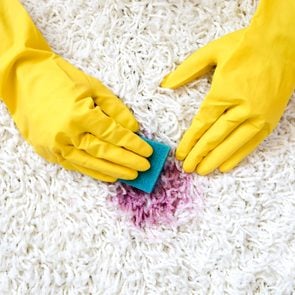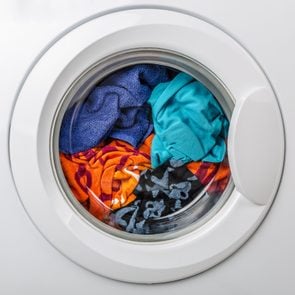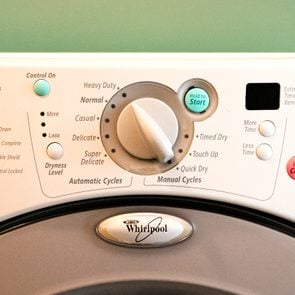How to Clean Your Dryer—and What Happens If You Don’t
Updated: Apr. 19, 2024
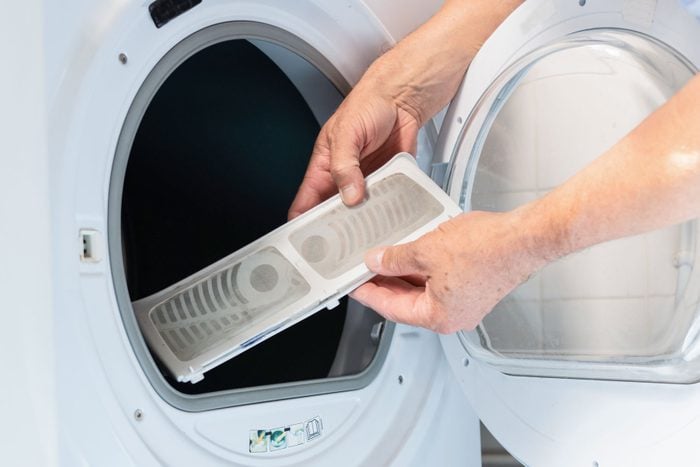
Buildup in dryer lint traps and vents can become a major fire hazard. To properly maintain your appliance, follow these expert-approved dryer cleaning tips.
You know the basics of dryer cleaning: You clear the lint trap after every load, and even use a lint brush to remove the excess fuzz that slips through the cracks. But lately, your clothes are coming out damp or taking longer to dry. And wasted time and energy are nothing compared with a bigger problem: fires. Clothing dryers cause thousands of home structure fires per year, and according to the U.S. Fire Administration, nearly one-third of those fires were caused by failing to clean the dryer. Dust, lint and even stray socks can build up and ignite, putting your family at risk.
But cleaning the lint trap is just the beginning. To help you tackle the dirty job of dryer cleaning, Reader’s Digest spoke with two dryer experts: Ken Rudolph, senior director of product management for clothes care at GE Appliances, and Haven Polich, product manager at Asko Appliances. They told us how important it is to clean everything in your dryer, from the lint trap and the drum to the exhaust.
Dryer buildup could be one reason your dryer isn’t drying (beyond being a fire hazard, dirty dryers are just plain inefficient and ineffective), and all that extra heat and tumbling action is tough on clothes. “Routine maintenance is important for all your appliances, and the dryer is no different,” Rudolph says. Because a clean, well-maintained dryer is safer and works better, the experts are walking us through each dryer-cleaning step. Read on to learn exactly how to clean your dryer—and how often you need to do it.
Get Reader’s Digest’s Read Up newsletter for more cleaning, humor, travel, tech and fun facts all week long.
About the experts
Reviewed for accuracy by: Ann Russell, TikTok’s “cleaning auntie” and the author of How to Clean Everything. |
How to clean your dryer
“Maintaining a clean dryer helps ensure proper performance,” Rudolph says. You’ll of course need to clean the dryer lint trap after every use (that’s an essential laundry tip), but you’ll also want to do a deep-clean on certain dryer parts once or twice a year, including the interior drum and the exhaust vent.
And with the exception of a dryer vent cleaning kit, which can be purchased online or at a home-improvement center, you likely have many of the supplies on hand. Here’s how to get the job done.
How to clean the dryer lint trap
“First, let’s start with the most basic and frequent maintenance,” Rudolph says. That’s your lint trap, and you need to add this to your cleaning schedule after every single use. “Lint accumulation varies based on the contents of your laundry,” Rudolph says, but could contain fluff and fibers from clothing, hair, dust and residues from detergents and dryer sheets. The lint trap catches these tiny particles so they don’t clog up your dryer vent, which carries the dryer’s exhaust outside your home.
Supplies you’ll need
- Lint roller or masking tape
- Dish soap
- Water
- Toothbrush or soft nylon brush
- Handheld vacuum or vacuum with hose attachment
How to clean the dryer lint trap after each use
- Remove the lint trap by pulling it up or out of its slot in the dryer.
- Gently peel the lint from the screen by hand.
- Put the lint trap back into its holder.
That’s it. Seriously. You may be tempted to wash the lint off, but it’s not necessary for routine dryer maintenance. Rudolph says to do a deep-clean twice a year, especially if you use dryer sheets.
How to deep-clean the dryer lint trap
- Remove the lint trap by pulling it up or out of its slot in the dryer. Dispose of the lint.
- Use a lint roller or masking tape to remove any stuck-on lint from both sides of the screen.
- Rinse the lint trap in hot water.
- Scrub with a nylon brush or toothbrush and warm, soapy water to remove buildup.
- Rinse and air-dry.
- While the lint trap is out, clean out the slot that holds the lint trap. Rudolph recommends using a vacuum with a hose attachment, extendable lint brush or a handheld vacuum to get deep down into the crevice.
- Put the lint trap back in the dryer only once it’s completely dry, to prevent mold from forming.
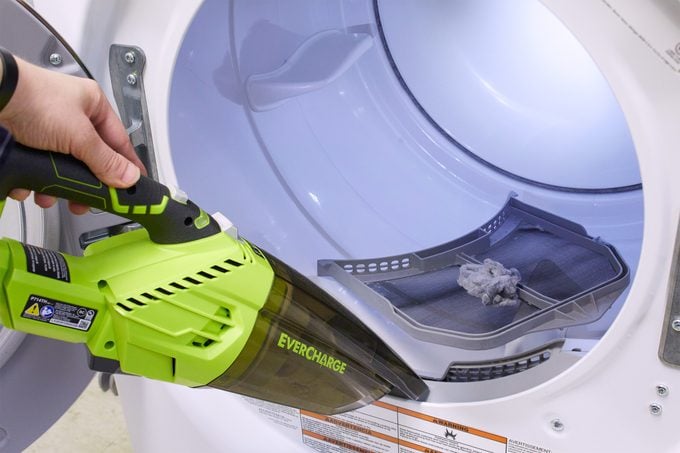
How to clean inside the dryer
Even though your clothes are clean when they go into the dryer, “fabric softener and dryer sheets can build up a film of sorts,” Polich says. This can be eliminated by wiping down the drum from time to time. Do it as needed if your dryer is not smelling so fresh. For an electric dryer, Polich recommends water and dish soap. For a gas dryer, she says a liquid, non-flammable household cleaner should be used. For a natural cleaning option for either dryer, a one-to-one solution of vinegar and water works well.
Supplies you’ll need
- Vacuum cleaner
- Dish soap or white vinegar
- Water
- Microfiber cloth
Directions
- Clean or vacuum any debris out of the drum.
- Using your preferred cleaning solution and a microfiber cloth, wipe down the interior of the drum.
- Rinse completely by wiping the drum with a wet cloth, sponge or towel.
- Tumble dry a load of clean clothes or towels.
- Remove the clothes once dry, and leave the dryer door open for air circulation when not in use.
How to clean the dryer vents and ducts
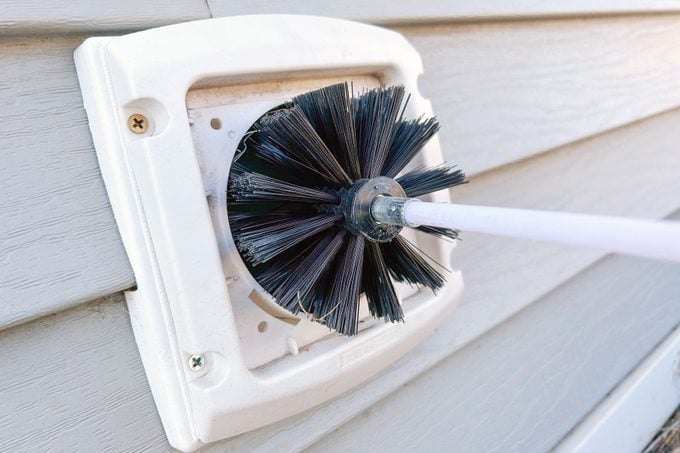
Knowing how to clean a washing machine and how to properly remove lint from a dryer seems like a pretty normal ask, but the dryer vent? That a lot. This ductwork carries hot air exhaust and lint all the way from your dryer to the exterior of your house, and if it gets clogged, that’s a fire hazard (and one that may take you a long time to notice).
Cleaning the dryer vent is the trickiest and most time-consuming task of dryer maintenance, which is why Rudolph recommends hiring a professional for ease and peace of mind. However, if you’re a handy DIYer, Rudolph says cleaning the exhaust “can be executed safely by a consumer.”
First, you’ll want to purchase a dryer vent cleaning kit at a home-improvement center or online. These kits come with a stiff bristle brush and a flexible, expandable rod that you use to push the brush into the vent. Then, follow these steps. If at any point you get stuck, or the vent doesn’t clear, call a pro.
Supplies you’ll need
- Vacuum cleaner
- Dryer vent cleaning kit
- Lint roller or masking tape
Directions
- Unplug your dryer and turn off the gas valve, if applicable.
- Detach the flexible tube from the back of your dryer and the wall.
- Vacuum out the vent tube with a vacuum and attachment.
- Locate your dryer’s exhaust vent on the exterior wall of your home, or the roof, and remove the cover. (Be careful climbing on your roof!)
- Add the brush attachment to a segment of flexible rod (from the dryer vent cleaning kit).
- Start from your laundry room. Push the brush into your dryer duct, spinning it clockwise to loosen clogged lint. (If it comes with a drill attachment, you may also use a power drill for this, always spinning clockwise.)
- Add segments to the flexible rod, taping them together for added security, as you push and spin the brush farther into the pipe.
- Reverse the brush once you reach the end, and vacuum to clean up any lint that came out of the duct.
- Replace the exterior duct cover and reconnect the vent pipe.
- Turn on the gas, plug in the power cord and slide your dryer back into place.
How often should a dryer vent be cleaned?
Once a year, according to Rudolph. Polich says it depends on a few factors, including the size of your family and how often you use your dryer. If you’re running multiple loads a day for a family of five, you may need to clean your vent more than once a year, but a single person can probably get away with every year or even less frequently.
FAQs
How can you tell if your dryer vent is clogged?
Most of the time, it’s slower-than-usual drying times. Blocked exhaust vents prevent moist air from escaping, which reduces dryer efficiency. “Many of our newer dryers have a ‘Check Vent’ feature, which indicates a reduced airflow condition from a possible blocked or restricted vent,” Rudolph says. “If your dryer does not have this feature, any changes in performance should trigger an inspection of the lint filter and duct.” Clean the filter, check the outside vent to see or feel if air is flowing and investigate if your dryer flashes an error code.
What is the sanitize cycle on a dryer?
“Many dryers have a ‘sanitary’ or ‘steam sanitary’ setting that can be used to sanitize clothing and laundry items using either steam or high heat,” Polich says. But don’t get too excited—this setting won’t clean your dryer, only your clothes. Polich says this setting is designed to work on fabric items without damaging them, and unfortunately the “temperatures and timing wouldn’t be high or long enough to sanitize the machine itself.” You may be able to sanitize the inside of your dryer with an antibacterial liquid cleaner, Polich says, but always check to see that it can safely be used on appliances.
Can I use Clorox wipes inside my dryer?
Wiping down the drum with bleach-free Clorox wipes won’t cause your dryer any harm, but it’s extremely important to use caution with gas dryers. Wipes may be flammable, depending on the formulation. Polich says best practices in dryer care call for gentle household cleaners like dish soap, coupled with physical removal of dust and debris.
Why trust us
At Reader’s Digest, we’re committed to producing high-quality content by writers with expertise and experience in their field in consultation with relevant, qualified experts. For this piece, Leah Groth tapped her experience as a seasoned home and cleaning reporter. Then cleaning expert Ann Russell, author of How to Clean Everything, gave it a rigorous review to ensure that all information is accurate and offers the best possible advice to readers. We verify all facts and data, back them with credible sourcing and revisit them over time to ensure they remain accurate and up to date. Read more about our team, our contributors and our editorial policies.
Sources:
- Ken Rudolph, senior director of product management for clothes care at GE Appliances; email interview, Jan. 11, 2024
- Haven Polich, product manager at Asko Appliances; email interview, Jan 5. 2024
- U.S. Fire Administration: “Clothes Dryer Fire Safety”

